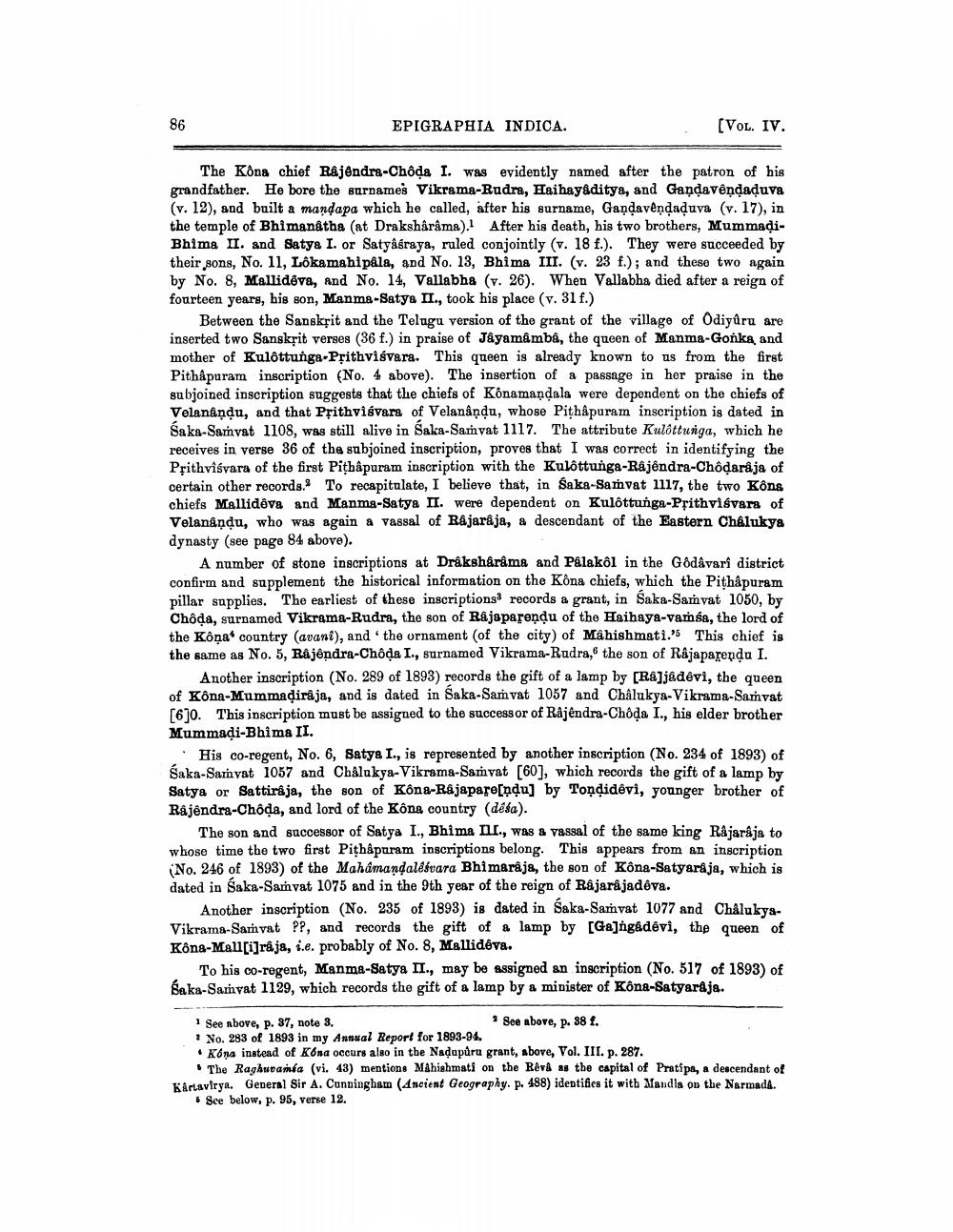________________
EPIGRAPHIA INDICA.
(VOL. IV.
The Kông chief Rajendra-Choda I. was evidently named after the patron of his grandfather. He bore the surnames Vikrama-Rudra, Haihayaditya, and Gandavendaduva (v. 12), and built a mandapa which he called, after his surname, Gandavendaduva (v. 17), in the temple of Bhimanátha (at Drakshârâma). After his death, his two brothers, MummadiBhima II. and Satya I. or Satyasraya, ruled conjointly (v. 18 f.). They were succeeded by their sons, No. 11, Lôkamahipala, and No. 13, Bhima III. (v. 23 f.); and these two again by No. 8, Mallidêva, And No. 14, Vallabha (v. 26). When Vallabha died after a reign of fourteen years, his son, Manma-Satya II., took his place (v. 31 f.)
Between the Sanskrit and the Telugu version of the grant of the village of Odigúru are inserted two Sanskrit verses (36 f.) in praise of Jayamamba, the queen of Manma-Gonka and mother of Kulottunga-Pșithvisvara. This queen is already known to us from the first Pithåpuram inscription (No. 4 above). The insertion of a passage in her praise in the subjoined inscription suggests that the chiefs of Konamandala were dependent on the chiefs of Velanându, and that Prithvisvara of Velanându, whose Pithapuram inscription is dated in Saka-Samvat 1108, was still alive in Saka-Samvat 1117. The attribute Kulôttunga, which he receives in verse 36 of the subjoined inscription, proves that I was correct in identifying the Prithvisvara of the first Pithapuram inscription with the Kulôttunga-Rajendra-Chôdarå ja of certain other records. To recapitulate, I believe that, in Saka-Samvat 1117, the two Kông chiefs Mallidôva and Manma-Satya II. were dependent on Kulôttunga-Pțithvisvara of Velanändu, who was again a vassal of Råjaraja, a descendant of the Eastern Chalukya dynasty (see page 84 above).
A number of stone inscriptions at Draksharama and Palakol in the Godavari district confirm and supplement the historical information on the Kồna chiefs, which the Pithapuram pillar supplies. The earliest of these inscriptions records a grant, in Saka-Samvat 1050, by Chôda, surnamed Vikrama-Rudra, the son of Rajaparendu of the Haihaya-varsa, the lord of the Konat country (avant), and the ornament of the city of Mahishmati.' This chief is the same as No. 5, Rajendra-Chôda I., surnamed Vikrama-Rudra, the son of Rajaparendu I.
Another inscription (No. 289 of 1893) records the gift of a lamp by [Ra]jadevi, the queen of Kôna-Mummadiraja, and is dated in Saka-Samvat 1057 and Chalukya-Vikrama-Samvat [6]0. This inscription must be assigned to the successor of Rajendra-Choda I., his elder brother Mummadi-Bhima II.
• His co-regent, No. 6, Satya I., is represented by another inscription (No. 234 of 1893) of Saka-Samyat 1057 and Châlokya-Vikrama-Samvat [60], which records the gift of a lamp by Satya or Sattiraja, the son of Kôna-Rajapare[du] by Toņdidêvi, younger brother of Rajendra-Choda, and lord of the Kôna country (désa).
The son and successor of Satya I., Bhima II., WAS & Vassal of the same king Rajaraja to whose time the two first Pithapuram inscriptions belong. This appears from an inscription No. 246 of 1893) of the Mahamandalesvara Bhimaråja, the son of Kône-Satyaraja, which is dated in Saka-Samvat 1075 and in the 9th year of the reign of Rajarajadova.
Another inscription (No. 235 of 1893) is dated in Saka-Samvat 1077 and ChalukyaVikrama-Samvat P?, and records the gift of a lamp by [Ga]ngadevi, the queen of Köna-Mall[i]raje, i.e. probably of No. 8, Mallideva.
To his co-regent, Manma-Satya II., may be assigned an inscription (No. 517 of 1893) of saka-Samvat 1129, which records the gift of a lamp by a minister of Kôna-Satyardja.
See above, p. 37, note 3.
See above, p. 88 f. No. 283 of 1893 in my Annual Report for 1893-94. • Kona instead of Kona occurs also in the Nadopůru grant, above, Vol. III. p. 287.
The Raghuvania (vi. 43) mentions Mahishmati on the Révå as the capital of Pratipe, a descendant of Kártavirya. General Sir A. Cunningham (Ancient Geography. p. 488) identifies it with Mandla on the Narmada.
6 See below, p. 95, verse 12.




